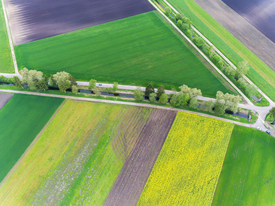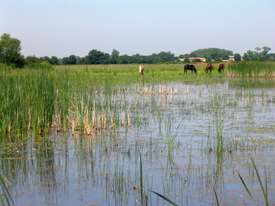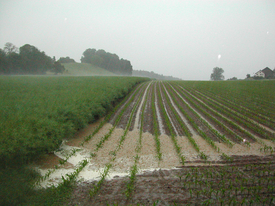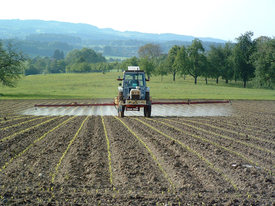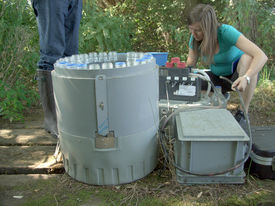Archive detail
Water protection a challenge for agriculture
September 5, 2017 |
Climate change and population growth mean that the conflicts between water protection and agriculture are here to stay. Dialogue on this topic is urgently needed within both society and the political arena to examine what goals should be set and how we should meet them. Research provides the groundwork for practical solutions, and Eawag has therefore devoted this year’s Info Day to the theme of “Agriculture and surface waters – Possible solutions to current challenges”. Nearly 300 experts from science, administration and politics came together today in Dübendorf to grapple with these areas of conflict. Among the topics presented were those outlined below; detailed information can be found in the conference transcript [pdf].
Decision-making with an eye to the consequences
“Science alone cannot bring together the conflicting goals of protection and production”, says water and agriculture expert Christian Stamm from Eawag, as the conflicts always entail the weighing-up of different goals. Research can provide decision-making support methods that allow the impacts of various possible courses of action to be presented transparently. Research can also contribute to finding solutions by developing innovative production technology, e.g. robots that apply plant protection sprays only where necessary instead of treating an entire field with herbicides. Is that sufficient for achieving sustainable yet intensive agriculture? Stamm thinks not: “Consumers will probably also have to adjust their expectations and demands where food is concerned.”
Construction of new pools and ponds
In order to make increased amounts of agricultural land available, streams have been straightened and obstructed for decades. The cantonal revitalisation programmes seek to reverse this trend. Frequently forgotten, however, are the small, non-flowing waterbodies: up to 90% of ponds and pools have disappeared as a result of the intensification of agriculture, says biologist Beat Oertli from the University of Applied Sciences, Western Switzerland in Geneva. This means a huge loss of biodiversity, as ponds are teeming with flora and fauna. Eight small waterbodies per ten square kilometres can still be found in parts of Switzerland. However, in regions of intensive agriculture there is often not even one small pond to be found in a comparable area. This also means a loss of other ecosystem services provided by these waterbodies, such as natural water purification, flood protection and protection against erosion. Drainage and backfilling not only endanger individual ponds, but also entire networks of small waterbodies within an area. Oertli therefore advocates improved protection for the remaining ponds, and says that, wherever possible, new ponds and pools should be created, including sufficiently wide riparian strips. “That is neither terribly difficult nor very expensive,” says Oertli.
More recuperation time for aquatic organisms
It is not only the urbanisation of streams that is an issue, but also their pollutant load. More than 100 plant protection chemicals have been found in tests, some of them in toxic concentrations. “The problem”, according to Eawag’s environmental chemist Heinz Singer, “is that it is not sufficient simply to look at individual substances in isolation. Certain organisms can suffer chronic damage from the long-term high concentrations and combinations of substances that occur in the streams”. There is hardly a time during the whole vegetation period when the water is unaffected or only slightly contaminated. Sensitive aquatic organisms thus have no time to recuperate. Singer expects therefore that only a broad palette of measures can improve the situation, as outlined in the federal action plan for plant protection.
Stringent measures require a high level of commitment
Christian Leu, head of the water quality section of the Federal Office for the Environment, is very hopeful about the “Action plan for reduced risk and sustainable use of plant protection products”. The plan is due be presented to the Federal Councillors this autumn. There is significant need for action in respect of waterbodies, but solutions do exist: the key elements of the plan consist of introducing new regulations governing the approval of substances, reducing the use of chemicals, and employing good practice and new technology to ensure that fewer chemicals run into the waterbodies whilst still ensuring that crops are protected. What is also important, according to Leu, is an increase in the number of aquatic investigations. Only then can it be shown whether or not the quality of these waters has really improved. “The measures are stringent. In order to implement them, a concerted effort is required on all sides”, emphasises the FOEN representative.
The Federal Office for Agriculture calls for a pioneer role for Swiss agriculture
The services should where possible be more environmentally friendly than at present and produce added value, says Eva Reinhard, the deputy director of the Federal Office for Agriculture. The goal is become an international pioneer in resource efficiency. Strong innovation, entrepreneurial thinking and knowledge of ecosystem services are key to this undertaking. Agricultural policy from 2022 onwards should bring together considerations of markets, environment and natural resources with those of the agricultural sector, in order to secure a future for agriculture and the food industry. Present day goals and measures, according to the Office for Agriculture representative, should be re-examined and, when necessary, questioned. Research plays a central role in this development. In this regard, Reinhard places great importance on new incentive systems and technologies well as increased digitalisation in agriculture. Specific local conditions must be taken into account; which will require further advancement of the methods for evaluating ecosystem services as well as practical monitoring systems.
Further information
We will be pleased to put you in touch with contacts in person at the conference site (Eawag-Empa Academy, Dübendorf) or by telephone. Please get in touch with Eawag’s media officer, Andri Bryner 058 765 51 04 / 079 721 19 93
Photos
Free use only in connection with media coverage on the Info Day
No archiving. Source reference: Eawag
Straightened, sunken and often also obstructed: streams in agricultural land are often under severe pressures – in addition to being contaminated with fertilizer and pesticides.
(photo: Markus Zeh)
Pesticides protect plants from pests and diseases. But they also leach into surface waters and ground water.
(photo: Eawag)
Photos: Peter Penicka, Eawag


